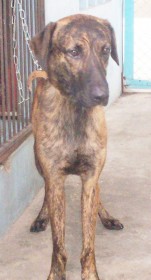Continued from last week
Last week, we dealt with poisonings that occurred because of stings and bites by poisonous insects and other life forms. But there are other ways through which a dog can become poisoned.
Toxic substances (poisons) are produced in some plants, eg, stinging nettle, certain mushrooms, etc. Also, some small animals (snakes, frogs, etc) can poison animals either via ingestion or contact with the skin or eyes/mouth. These plant poisons can elicit vomiting, gastro-intestinal cramps and abdominal pain, even diarrhoea. In some cases, the animals tremble and they develop cardiac (heart), respiratory (lungs) and liver/kidney problems.
On other occasions, the plant poisons bring about skin rashes and other allergic reactions which might also express themselves as mouth (lip) swellings and an enlargement of the tongue, and the face in general.

Our Guyanese poisonous toad secretes a potent toxin which has an effect on the dog’s heart and blood circulatory and nervous systems. The dog could exhibit convulsions and tetanic cramps (stiffness) in the neck and extremities. The dog gets stiff as a board and it shows great respiratory distress (it gasps for air, since the function of the diaphragm, a muscle, is compromised). The dog can actually die within an hour, if there is no veterinary intervention.
The number of symptoms exhibited and the degree of morbidity will depend on the toxicity of the toad’s poison and on how much of the poison got into the dog’s blood circulation.

Here in Guyana, snakes abound. But not only are most snakes non-venomous, but snakes are more scared of humans and dogs than vice versa. The bites of non-poisonous snakes may, at the most, create a local reaction at the bite site. If the snake has a full complement of developed teeth, one might be able to discern the set of teeth marks in the shape of a horseshoe. On the other hand, if the bite is from a poisonous snake, there will often be discernible fang marks, and the skin would have been punctured.
Snake bite symptoms will include restlessness, panting, drooling, weakness and collapse of (hind) legs. Later on, a diarrhoea and/or urinary incontinence might develop. Finally, epilepsy-like seizures and paralysis could occur. Shock conditions, coma and death follow.
There are quite a few other possibilities related to poisonings in animals. Neither owners nor veterinarians take some of these possibilities into consideration. Here are some examples of what I mean; examples which force us all – pet owners and vets – to think outside the box:
Case 1: The dogs are showing all the signs of poisoning, yet nothing in the owner’s story points to any contact between the pets and poison. The owner’s premises were visited and nothing was found to substantiate the poisoning diagnosis. As I was about to leave, the maid mentioned, in passing how the mosquito burden was intolerable. I returned to the kennels. Lo and behold, the tin stands on which the mosquito coils are fastened were quite visible. On further questioning, it was related that the smoke from the mosquito coils was concentratedly going through the floor boards in the kennels thus poisoning the dogs.
Case 2: Similar to the case above. The next door neighbour recently began a spray painting establishment in which the spray was going straight into the kennels which housed the dogs.
Case 3: A visit to the premises revealed that the dog was eating the plant fertilizer – unbeknownst to the owner.
Case 4: A dog exhibiting symptoms of possible lead poisoning was found to be licking the lead paint off the wall and gnawing at some old lead fittings from a discarded toilet system.
Case 5: Let us always take as many precautions as we can to safeguard our pets when we call in the professional/non-professional vermin exterminators. Too many dogs/cats have died after the exterminators have departed not lastly because we do not follow their advice.
Case 6: We might be using skin washes with insecticidal properties for years without any problems. Similarly, rat baits might have been distributed (securely, we think) around the house with no serious health repercussions relative to our pets. Yet, we must always take into consideration that these chemical substances could have found their way into the animal’s body – via ingestion or cracks in the skin, situations which have never occurred before.
Next week we will deal with the treatment of poisons.
Please implement disease preventative measures (vaccinations, routine dewormings, monthly anti-heartworm medication, etc) and adopt-a-pet from the GSPCA’s Animal Clinic and Shelter at Robb Street and Orange Walk, if you have the wherewithal to care well for the animals. Do not stray your unwanted pets, take them to the GSPCA’s Clinic and Shelter instead. If you do not wish your pet to have puppies or kittens, you may exploit the GSPCA’s free spay and neutering programme. If you see anyone being cruel to an animal, or if you need any technical information, please get in touch with the Clinic and Shelter by calling 226-4237.




